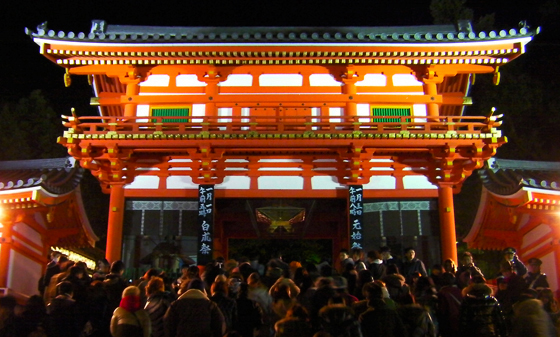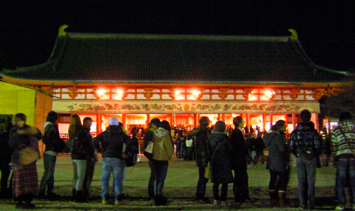
Okera mairi at Yasaka Jinja is ideal for celebrating New Years if you enjoy large crowds.
The end of the year is a big deal in Japan just as it is in most places but with some fairly unique differences. Most of the clubs, etc. still have the usual Western-style parties and countdown events but there is also the traditional side, which at least in Kyoto involves a lot more bell ringing, fire and consumption of significant foods and beverages.
I hadn’t done the traditional thing for a long while so when a Japanese friend invited me this time around, I decided to brave the cold and revive some admittedly really hazy memories. I only found out later that my friend’s family doesn’t follow the usual customs so this was her first time out. For a couple of novices, it went pretty well but we will probably do a few things differently next time.
Okera mairi
We had planned to visit Yasaka Jinja Shrine (八坂神社) first to see the Okera mairi event and then go next door to Chionin (知恩院) for the Joya no kane bell ringing ceremony. Okera mairi is an ancient custom unique to Yasaka and involves building fires in large metal lanterns using the dried roots of the okera plant, a traditional medicinal herb. Shrine-goers then light long tapers from the lanterns to take home and use in preparing zoni broth, attracting good luck and health.
To keep the embers alive, the taper should be swung in (gentle) circles as you walk. It all looks very atmospheric in the photos so off we went. Unfortunately by the time we arrived at around 10:45, Kyoto’s finest had blocked off access to the shrine, leaving only one bottlenecked entrance jammed with several hundred people. In the 15 minutes we waited, the queue moved less than a meter.
Figuring we would come back later, we dug our way out of the squash and headed to Chionin, which also already had its gates blocked… Not an auspicious start to the evening but for the record, a lot of other people were also stood around wondering what was happening. Lesson for next time: don’t spend so long on dinner; early is good!
Joya no kane
Seeing the Joya no kane ceremony at Chionin is definitely on my list for next time. The massive 70 ton bell dates to 1636 and is rung by a team of 17 monks, who probably can’t hear a whole lot for several days after. (Many thanks to Jason Collin for the video.) But this year, it was time for plan B, which was to go to a smaller, neighborhood temple.
Unless you are up for the crowds, spending the evening at a local place is probably a friendlier option. Just find somewhere in your area with a ji or dera (寺) – also sometimes in (院) or do (堂) – at the end of its name, indicating a Buddhist temple. Shinto shrines, where you go for Hatsumode, are usually followed by jinja (神社) or jingu (神宮). Kyoto has around 1,600 temples and 400 shrines so you are not short on choices.
As it turned out, on the way to the place I had in mind, we heard another bell and followed it to a different temple. A monk there invited us in and we found ourselves close to the front of the queue. Just by luck, we actually ended up ringing the bell at almost exactly midnight in an atmospheric old belfry and also received a cool Chinese zodiac amulet for the coming year. All very serendipitous and surely worth a few karma points.
If you’re not familiar with Joya no kane, at the end of each year, a temple’s bell is struck 108 times to release each of the bonno or earthly desires believed to cause human suffering. The temple’s monks and parishioners go first and then visitors can usually take part – at least at the smaller places. The ceremony starts before midnight and seems to continue until the ringing is done. We continued on to our original destination and things were still in full swing there.

Long queue waiting during Hatsumode at Heian Jingu
Hatsumode
It was pretty cold by this time but we decided to try an early Hatsumode and headed to nearby Heian Jingu (平安神宮). Hatsumode is the first visit to (usually) a Shinto shrine for the new year. Here too most people ring the bell and make offerings to attract luck. Many also check their fortunes for the coming year or buy large arrow-shaped amulets. It’s best to cover all your bases.
As expected, there was a long queue but we were happy to draw our fortunes and soak up the ambience of the illuminated buildings and grounds. This visit can be made anytime in the first few days of the New Year and many people wait for the crowds to thin. Others, however, seem set on being the first through the gate, as we saw in a fairly surreal moment on the way home.
We had decided to give Okera mairi another try and returned to Yasaka Jinja, stopping along the way to warm up on some excellent amazake spiced with ginger. Unfortunately the police were still on the job and by then had even cordoned off the street leading to the shrine. Behind this yellow tape, around 200 or so shadowy figures were massed, waiting for a chance to be Yasaka’s first Hatsumode visitors of the year.
The folks at the front looked… focused, I guess priming themselves for a quick burst of passive-aggressive speed walking. Kinda spooky in the half-light… Either way, we didn’t wait around for the tape to drop and continued back to the Keihan line. The trains run all night on the 31st / 1st so you have plenty of time to farewell the old year and welcome the next.
Resources and other details
Yasaka Jinja Shrine: Japanese Web site and English Web site
Chionin Temple: Japanese Web site and English Web site
Heian Jingu Shrine: Japanese Web site and English Web site
